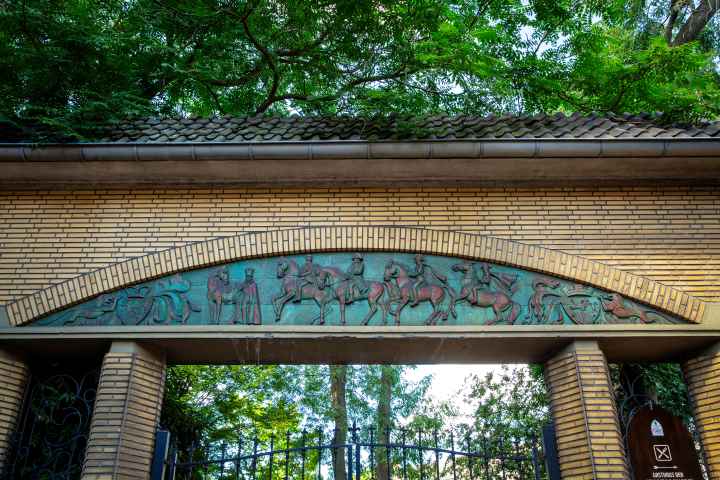Napoleon tympanum
Keizerstraat
Napoleon tympanum – Sef Moonen
The tympanum with the image of Napoleon and his horsemen is located above the gate of the former cloister Mariaweide. The cloister garden behind it is only accessible to residents and the Venlo city guides. They take visitors into this garden to see the oldest remaining structure in Venlo: a 60-metre-long remnant of the Venlo city wall from 1350, with the remains of a watchtower.
The image on the tympanum was probably made in memory of the visit of Emperor Napoleon Bonaparte to Venlo in 1804. He is said to have used the Keizerstraat as an escape route to escape a waiting crowd that wanted to welcome him. The artwork is by Venlo artist Sef Moonen, the gate was designed by architect Ben Hendrix.
Artist: Sef Moonen
Jozef Maria Hubertus Antonius (Sef) Moonen (1906 -1995) was a painter from Venlo. He went to the Rijks HBS in Venlo after which he continued his studies by studying drawing at the Katholieke Leergangen in Tilburg and then at the Rijksakademie voor Beeldende Kunsten in Amsterdam.
After completing his studies in 1933, he started teaching himself, including to students at the Venlo Pedagogical Academy from 1954 to 1971. In his early years of painting, he produced large canvases, later in life smaller ones, mainly still lifes and occasionally landscapes.
Moonen was of great significance to Venlo’s cultural life. He was among the founders of the Free Academy in Venlo, the Kunstkring Kyra and the Filmkring Venlo. Moonen was also active as a sculptor and designer of stained-glass windows.
Keizerstraat
The Keizerstraat is also called ‘Floddergats’ by the people of Venlo. That was back in the days when the part of the street between Ursulastraat and Nieuwstraat was still a narrow, muddy corridor. The street was constructed in 1652 and served from the Keulsepoort as access to the cloister quarter and the cloisters Mariaweide and Trans-Cedron located there. Originally, the street was called Kloosterstraat, although in the 17th century it was also called Enge Begijnengang. This changed after Emperor Napoleon and his retinue allegedly rode through the street in 1804. His horse supposedly lost a horseshoe there, and that horseshoe has always been preserved.
In the last decades of the 20th century, Keizerstraat was quite rundown and there was a lot of drug abuse and violence. The Dominican Fathers decided to limit this nuisance by placing a fence along the side of the Dominican chapel. Partially due to the efforts of housing corporation Woonwenz and a few entrepreneurs, the Keizerstraat has now changed into a pleasant and lively street where people like to walk around and stroll.


